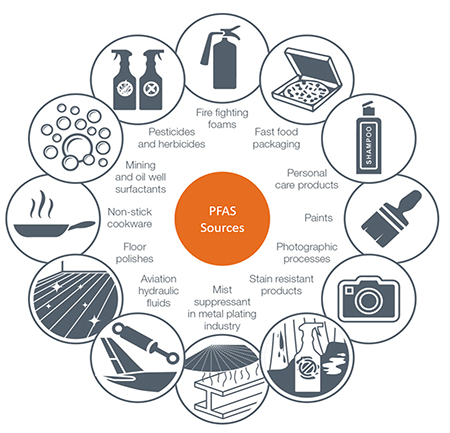When you approach the Truckee river, you’re faced with one of Northern Nevada’s many beautiful bodies of freshwater. Although, it now comes with an additional catch: there’s a possibility that this water isn’t as safe as we’re to believe, and it can affect the fish that come from it.
Freshwater fish in the United States are turning up with “forever chemicals” in their systems that prove not only harmful to the animals themselves, but to the humans who consume them. This poses a problem for the people who fish for sustenance, particularly individuals who are often poorer and do not have the means to access store-bought fish that contain less of these contaminants.
Forever chemicals are pollutants that will remain in the fish for years to come. By their scientific name, polyfluoroalkyl substances (PFAS) have now come under the attention of the Biden administration. The Environmental Protection Agency (EPA) wants to combat and alleviate this man-made problem across the country. Efforts for this include actions such as removing lead pipes from the plumbing that provide Americans with drinking water.
According to a report published by NPR’s Mountain West Bureau in February, PFAS levels are six times the national average in New Mexico, Wyoming, and Colorado – which can be concerning to our local fisher people due to the proximity.
For people in Reno who fish in Washoe County waters or who travel to California to Frenchman’s Lake and others, this might be of concern. One of the closest observed bodies of water to the area that is greatly affected with these PFAS – according to this interactive map provided by the Environmental Working Group – is the Feather River in the Sierra Nevada region.
While PFAS levels in Nevada appear lower in studies, just during the last week in April, officials from Washoe County, the City of Reno, Truckee Meadows Water Authority (TMWA), and the Nevada Division of Environmental Protection announced that they will investigate water samples from Swan Lake. The concern was first raised by a University of Nevada, Reno graduate students who found PFAS in large quantities from samples they took in August 2021.
On its website TMWA states that Swan Lake “is not a source of drinking water” for that community and that it does not infiltrate local groundwater supplies. However, fishing is still allowed though not recommended by the county.
“… Anyone who is concerned about exposure to PFAS should refrain from swimming, fishing, or other activities in the lake until more information is available,” said Bethany Drysdale, a Washoe county spokesperson. “We have a single data point for PFAS at Swan Lake for now, and that data point is from 2021. We have no data on the presence of PFAS in fish or wildlife at the lake.”
Also concerned about PFAS is Paola Miramontes, an environmental science student and McNair Scholar at UNR who currently studies urbanization and how it affects streams around cities. She actively researches the dynamic state of the water quality in Reno and how toxins’ access the Truckee river, which is mainly through our storm drains, and why and how it’s accessing the river.
She already has ideas about how people can help resolve this preventable problem.
“I really like to advocate for using less fertilizers, road salts, and limiting water runoff. There are many streams and creeks throughout the Reno area that flow into the Truckee river and can transport harmful contaminants into the river,” Miramonte said. “By limiting the use of products with harmful chemicals we can prevent pollutants from entering freshwater and impacting wildlife.”
On the other hand, the fish sold in your local grocery store are often safer due to how they are grown – in a seafood farm – which take place in cleaner, intervened bodies of water, so the risk of PFAS is far less significant than when looking into store-bought products. For example, Whole Foods Market explains on their website their quality standards for their seafood products.
But if you don’t buy their fish and instead catch them in the local bodies of water, those fish are more susceptible to PFAS. Even the White House warned that people who fish for sustenance are often disproportionately affected by this issue, as well.
Jim Litchfield is a local guide and owner of the Reno Fly Shop, and he has been fishing in the area since the mid-eighties. He’s noticed two causes for concern in regards to our local waters.
“Litter seems to be the current condition that gets the most comments from customers and guided clients,” Litchfield has observed. And as for a solution? “Mitigated with community driven river clean ups, a public informational campaign on the disposal of micro trash and hand held litter could have great benefit. I would also suggest a similar campaign that educates the public [on] discharging liquids into storm sewers that can [also] negatively impact water quality.”
Micro trash can be defined as something that may seem minute when seen in the vast wilderness, but definitely adds up over time. From bottle caps to cigarette butts, little bits of trash can still have a great impact, even with the minuscule name.
Despite these concerns, and the current news from Swan Lake, you can rest assured that while we should always keep water in mind and reduce the pollution in our streams and lakes, there are little traces of PFAS in the Reno area according to the Nevada Division of Environmental Protection (NDEP) and the Nevada Department of Wildlife (NDOW).
“At this point no significant levels of PFAS have been detected in Nevada fish,” said Ashley Sanchez, a spokesperson with NDOW. “We understand there are concerns around PFAS, but there is no immediate cause for alarm in Nevada.”
Reporting by Mariya Dawson and Claudia Cruz; translated by Melissa Bustos

